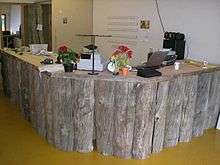Snag (ecology)


In forest ecology, a snag refers to a standing, dead or dying tree, often missing a top or most of the smaller branches. In freshwater ecology it refers to trees, branches, and other pieces of naturally occurring wood found sunken in rivers and streams; it is also known as coarse woody debris. When used in manufacturing, especially in Scandinavia, they are often called "dead wood" and in Finland "kelo wood".
Forest snags
Large standing snags provide critical habitat for many species both faunal and avifaunal such as woodpeckers that feed on insects dwelling in decomposing wood. Because snags are a result of decay, they are soft enough for woodpeckers and other cavity excavators to make entrance holes and cavities. Snags often lack branches and dense canopies which allow for unobstructed flight movements by birds during predation. This makes snags optimal habitat for woodpeckers such as the pileated woodpecker which create the majority of cavities used by secondary cavity users in forest ecosystems. Because snags are not resourceful for timber harvests, they are often left behind and help maintain the biodiversity of the area which may have otherwise been lost. In the Puget Sound ecosystem, research and observations have shown that the pileated woodpecker excavates cavities for more than 80 species and the stabilization of their population relies on snags being conserved during or after timber harvests.
Snag persistence depends on two factors, the size of the stem, and the durability of the wood of the species concerned. The snags of some large conifers, such as coast redwood on the Pacific Coast of North America and Alerce in Patagonia, can remain intact for 100 years or more, becoming progressively shorter with age, while other snags with rapidly decaying wood, such as aspen and birch, break up and collapse in 2–10 years.
Snag trees are referred to for various bird species. Water hunting birds like the osprey or kingfishers can be found near water, perched in a snag tree, or feeding upon their fish catch.
Freshwater snags
In the freshwater ecology in Australia and the United States, the term snag is used to refer to the trees, branches and other pieces of naturally occurring wood found in a sunken form in rivers and streams. Such snags have been identified as being critical for shelter and as spawning sites for fish, and are one of the few hard substrates available for biofilm growth supporting aquatic invertebrates in lowland rivers flowing through alluvial flood plains. Snags are important as sites for biofilm growth and for shelter and feeding of aquatic invertebrates in both lowland and upland rivers and streams.
In Australia, the role of freshwater snags has been largely ignored until recently, and more than one million snags have been removed from the Murray-Darling basin. Large tracts of the lowland reaches of the Murray-Darling system are now devoid of the snags that native fish like Murray cod require for shelter and breeding. The damage such wholesale snag removal has caused is clearly enormous, but is difficult to quantify (but see ). Most snags in these systems are river red gum snags. As the dense wood of river red gum is almost impervious to rot it is thought that some of the river red gum snags removed in past decades may have been several thousand years old.
Maritime Hazard
Also known as deadheads, partially submerged snags posed hazards to early riverboat navigation and commerce. If hit, snags punctured the wooden hulls used in the 19th century and early 20th century. Snags were, in fact, the most commonly encountered hazard, especially in the early years of steamboat travel.[1] In the United States, the U.S. Army Corps of Engineers operated "snag boats" such as the W. T. Preston in the Puget Sound of Washington State and the Montgomery in the rivers of Alabama to pull out and clear snags. Starting in 1824, there were successful efforts to remove snags from the Mississippi and its tributaries.[1] By 1835, a Lieutenant reported to the Chief of Engineers that steamboat travel had become much safer, but by the mid-1840s the appropriations for snag removal dried up and snags re-accumulated until after the Civil War.[1]
"Dead wood" products
In Scandinavia and Finland snags, invariably pine trees, known in Finnish as kelo and in Swedish as torraka, are collected for the production of different objects, from furniture to entire log houses. Commercial enterprises market them abroad as "dead wood" or in Finland as "kelo wood". They have been especially prized for their silver-grey weathered surface in the manufacture of vernacular or national romantic products. The suppliers of "dead wood" emphasise its age: the wood has developed with dehydration in the dry coldness of the subarctic zones, the tree having stopped growing after some 300–400 years, and the tree has remained upright for another few hundred years. "Dead wood" logs are easier to transport and handle than normal logs due to their lightness.
See also
| Wikimedia Commons has media related to Snag. |
| ||||||||||||||||||||||||||||||